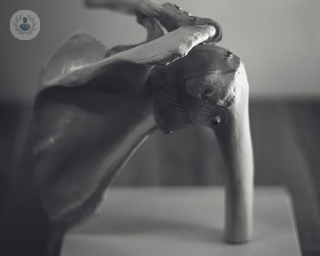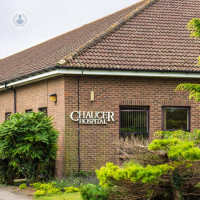Shoulder replacement
Mr Andrew Chambler - Orthopaedic surgery
Created on: 03-12-2018
Updated on: 06-12-2023
Edited by: Jay Staniland
What is shoulder replacement surgery?
Shoulder replacement surgery involves removing and replacing the damaged parts of the shoulder (usually the head of the humerus and scapula) with artificial implants. These are either made out of plastic or metal, or sometimes both. These implants are usually held in place using a special cement, or if they allow new bone growth, then cement is not required permanently. Although shoulder replacement surgery is less common than knee or hip replacement surgery, it can be just as effective in relieving shoulder joint pain.

Why would you need shoulder replacement surgery?
Shoulder replacement surgery will usually be recommended if non-surgical treatments, such as medication or changes in physical activity have not been successful in relieving pain. You can experience shoulder pain for a number of reasons, including:
- age-related wear and tear shoulder arthritis
- rheumatoid arthritis
- injury-related arthritis
- rotator cuff tear
- severe shoulder fractures
- failed previous shoulder replacement surgery. This is known as revision shoulder replacement.
What does shoulder replacement surgery involve?
There are several types of shoulder replacement surgery:
- Total shoulder replacement – the arthritic joint surfaces are replaced with a metal ball (on the head of the humerus) and a plastic socket is attached to the shoulder joint.
- Stemmed hemiarthroplasty – just the ball of the shoulder joint is replaced.
- Resurfacing hemiarthroplasty – the head of the humerus is surfaced with a cap implant.
- Reverse total shoulder replacement – a metal ball is attached to the shoulder bone and a plastic socket is attached to the upper arm bone.
How to prepare for shoulder replacement surgery
Before surgery, certain medications will need to be stopped. It is also important to prepare your home prior to surgery, to make recovery easier. This includes, moving essential things to low-level shelves and having everything easily available. Before surgery you should wear loose-fitting clothes, with a button down shirt that allows easy removal after surgery. Surgery is performed with either general anaesthetic or regional anaesthetic.
Post-operative care
After surgery, you will be given antibiotics to lower the risk of infection. Your arm will be in a sling and will have minimal movement. Patients generally return home after 2-3 days following surgery. Pain medication will be prescribed for the short-term, but will be carefully monitored. Physical therapy is also crucial to a good recvoery, and soon after surgery movement will be possible. Driving is not permitted for two to four weeks following surgery.

















